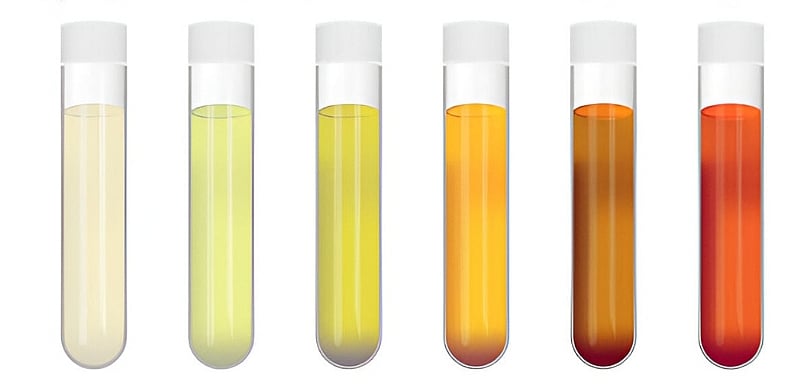Urine
Urine is a liquid waste product that contains water and other substances, including urea, filtered from the blood by the kidneys. The urine goes to the bladder, where it is stored until you are ready to urinate. Finally, the urine leaves the body through the urethra. It is composed of water, urea, uric acid, and other substances.
Color
Normal urine is a pale straw or transparent yellow color. Darker yellow or honey-colored urine may indicate a need for more water; a darker, brownish color could mean liver problems or severe dehydration. The regular color of urine varies, depending on how much water you drink. Fluids dilute the yellow pigment in urine. So, the more water you drink, the clearer your urine looks. The less water you drink, the stronger the yellowish color becomes.
But urine can turn colors far beyond what’s typical, including:
Red Orange Blue Green Dark brown Cloudy white
Red urine
Red urine is not always a sign of a serious health problem. Red or pink urine can be caused by blood in the urine due to health problems, including an enlarged prostate, tumors that aren’t cancer, and kidney stones and cysts. Some cancers can also cause blood in the urine. Hard exercise, such as long-distance running, can also cause bleeding. Beets, blackberries, and rhubarb can turn urine red or pink. A tuberculosis medicine called rifampin (Rifadin, Rimactane) can turn urine reddish-orange. Similarly, a medicine for urinary tract pain called phenazopyridine (Pyridium) can also cause this change. Constipation medications containing Senna can also bring on this change.
Orange urine
This can be caused by phenazopyridine and some constipation medications. Some chemotherapy medications for cancer can also make urine look orange. Some vitamins, such as vitamin A and B12, can turn urine orange or yellow-orange.
Blue or green urine
This can be a sign of a problem with the liver or bile duct, mainly if you also have light-colored stools. Dehydration can also make your urine look orange. Blue or green urine can be caused by dyes from foods or medical tests. A medicine for depression called amitriptyline can make urine look greenish-blue. A treatment for ulcers and acid reflux called cimetidine (Tagamet HB) can also cause this change. A water pill called triamterene (Dyrenium) and propofol (Diprivan), a strong medicine that helps people sleep or relax before surgery, can also cause blue or green urine. A rare disease called familial benign hypercalcemia can cause children to have blue urine. Urinary tract infections caused by a certain type of bacteria can cause green urine.
Dark brown or cola-coloured urine
This can be caused by eating lots of fava beans, rhubarb, or aloe. Some medicines that can darken urine are chloroquine and primaquine, which treat and prevent malaria. The antibiotics metronidazole (Flagyl, MetroCream, and others) and nitrofurantoin (Furadantin, Macrobid, and others) can also cause dark brown urine. Constipation medications containing senna (Senokot, Ex-Lax, and others) can also cause dark urine. Methocarbamol (Robaxin), a muscle relaxer, and the seizure medicine phenytoin (Dilantin, Phenytek) can also cause dark brown urine. Medicines called statins that lower cholesterol can also cause dark urine. Some liver and kidney disorders and some urinary tract infections can turn urine dark brown. Bleeding inside the body, called hemorrhage, and a group of illnesses that mainly affect the skin or the nervous system, called porphyria, can also cause dark brown urine. A muscle injury from extreme exercise can cause tea or cola-colored urine, which can lead to kidney damage.
Cloudy or murky urine
This can be caused by urinary tract infections and kidney stones.
Risk Factors
According to Dr. KwabenaOkyere from King Medical Consult (Specialist Urology Clinic) in Santasi, Kumasi, changes in urine color that aren’t due to water, food, or medicine could be caused by a health problem. Some factors that put someone at risk of health problems that can affect urine color include:
Age
Tumors of the bladder and kidney, which can cause blood in the urine, are more common in older adults, especially those with an enlarged prostate gland.
Family history
Relatives, such as a parent, sibling, or grandparent, with kidney disease or kidney stones are more likely to develop these conditions, which can cause blood in the urine.
Hard exercise
People, who engage in hard exercise such as distance running, are more likely to have blood in their urine.
Dr. Okyere advises that if you notice any unusual changes in your urine color, you should consult a healthcare professional to rule out any underlying health issues.
Mustapha Bature Sallama
Medical/Science Communicator
[email protected]


